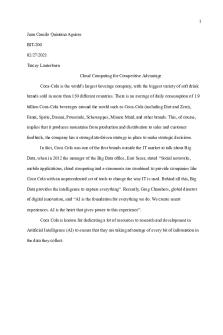Competitive Advantage of Groupon PDF

| Title | Competitive Advantage of Groupon |
|---|---|
| Author | pankaj aggarwal |
| Course | Leading, Managing and Developing Organisations |
| Institution | University of Sunderland |
| Pages | 1 |
| File Size | 69 KB |
| File Type | |
| Total Downloads | 3 |
| Total Views | 155 |
Summary
Case Study of Groupon for competitive advantage...
Description
‘VRIO’ STRATEGIC CAPABILITIES AS A BASIS OF COMPETITIVE ADVANTAGE
81
ILLUSTRATION 3.3
Groupon and the sincerest form of flattery When a firm identifies a new market niche it must also make sure its strategic capabilities are valuable, rare, inimitable and supported by the organisation.
Chicago-based Groupon was launched in 2008 by Andrew Mason with the idea to email subscribers daily deals of heavily discounted coupons for local restaurants, theatres, spas, etc. Groupon sells a coupon for a product and takes up to half of the proceeds, which represent a big discount on the product’s usual price. In return, Groupon aggregates demand from the customers who receive its emails and this provides exposure to and increased business for the local merchants. The venture rapidly became the fastestgrowing Internet business ever and grew into a daily deal industry giant. In 2010 Groupon rejected a $6 bn (€4.5 bn) takeover bid by Google and instead went public at $10 bn in November of 2011. While Groupon’s daily deals were valued by customers – the company quickly spread to over 40 countries – they also attracted first hundreds and later thousands of copycats worldwide. Investors started to question Groupon’s business model and to what extent it had rare and inimitable strategic capabilities. In 2012 the CEO Andrew Mason denied in Wall Street Journal (WSJ) that the model was too easy to replicate: ‘There’s proof. There are over 2000 direct clones of the Groupon business model. However, there’s an equal amount of proof that the barriers to success are enormous. In spite of all those competitors, only a handful are remotely relevant.’ This, however, did not calm investors and the online coupon seller’s shares promptly fell by 80 per cent to its all-time low. The question thus remained – to what extent were Groupon’s capabilities rare and inimitable? One significant asset Groupon had that is rare and possibly difficult to imitate is its impressive customer base of more than 50 million customers. The more customers, the better deals and this would make customers come to Groupon rather than the competitors and the cost for competitors to acquire customers would go up. Critics argued, however, that other companies such as Facebook, Google and Amazon had even broader user bases and could possibly
become competitors. Further defending Groupon’s competitiveness the CEO emphasised in WSJ that it is not as simple as providing daily deals via email, but that a whole series of things have to work together and to imitate Groupon competitors would have to replicate everything in its ‘operational complexity’: ‘People overlook the operational complexity. We have 10,000 employees across 46 countries. We have thousands of salespeople talking to tens of thousands of merchants every single day. It’s not an easy thing to build.’ Another resource that Andrew Mason stressed was Groupon’s advanced technology platform that allowed the company to ‘provide better targeting to customers and give them deals that are more relevant to them’. Part of this platform, however, was got via acquisitions – a route competitors possibly could take as well. If imitation is the highest form of flattery Groupon has been highly complimented. Hundreds of copycats have, however, left the business and Groupon has also beaten back more serious competitors, but the company continues to be under considerable pressure. In February 2013 founder and CEO Andrew Mason was forced to step down, which was a sign that many changes would come at Groupon. Sources: All Things Digital, 2 November 2012, Wall Street Journal: http://allthingsd.com/20121102/groupon-shares-dive-to-new-low-ayear-after-the-ipo/; Financial Times, 14 May 2012; Financial Times, 2 March 2013; Wall Street Journal, 31 January 2012.
Questions 1 Andrew Mason admits that Groupon has thousands of copycats, yet his assessment is that imitating Groupon is difficult. Do you agree? 2 Assess the bases of Groupon’s strategic capabilities using the VRIO criteria (Figure 3.2 and Table 3.2 ). 3 Which is the most important strategic capability that provides, or could provide, Groupon with sustainable competitive advantage?...
Similar Free PDFs

Competitive Advantage of Groupon
- 1 Pages

Apple competitive advantage
- 18 Pages

Mapping Competitive Advantage
- 6 Pages
Popular Institutions
- Tinajero National High School - Annex
- Politeknik Caltex Riau
- Yokohama City University
- SGT University
- University of Al-Qadisiyah
- Divine Word College of Vigan
- Techniek College Rotterdam
- Universidade de Santiago
- Universiti Teknologi MARA Cawangan Johor Kampus Pasir Gudang
- Poltekkes Kemenkes Yogyakarta
- Baguio City National High School
- Colegio san marcos
- preparatoria uno
- Centro de Bachillerato Tecnológico Industrial y de Servicios No. 107
- Dalian Maritime University
- Quang Trung Secondary School
- Colegio Tecnológico en Informática
- Corporación Regional de Educación Superior
- Grupo CEDVA
- Dar Al Uloom University
- Centro de Estudios Preuniversitarios de la Universidad Nacional de Ingeniería
- 上智大学
- Aakash International School, Nuna Majara
- San Felipe Neri Catholic School
- Kang Chiao International School - New Taipei City
- Misamis Occidental National High School
- Institución Educativa Escuela Normal Juan Ladrilleros
- Kolehiyo ng Pantukan
- Batanes State College
- Instituto Continental
- Sekolah Menengah Kejuruan Kesehatan Kaltara (Tarakan)
- Colegio de La Inmaculada Concepcion - Cebu












